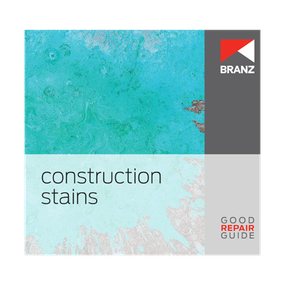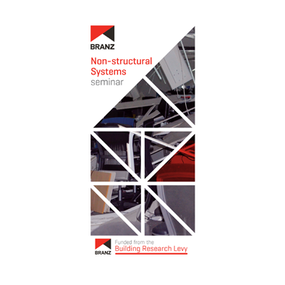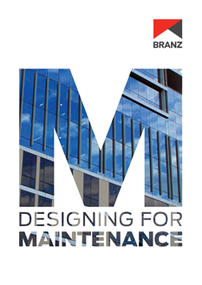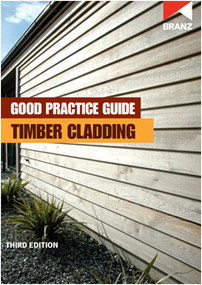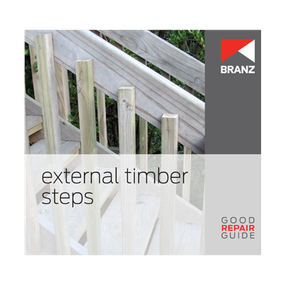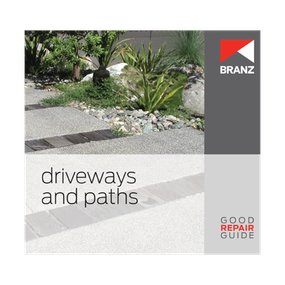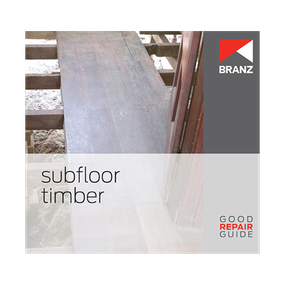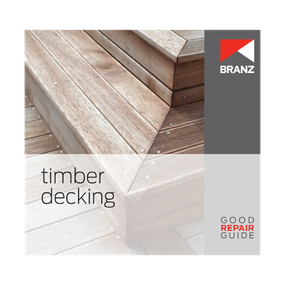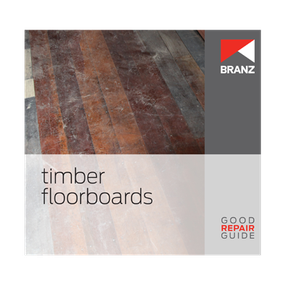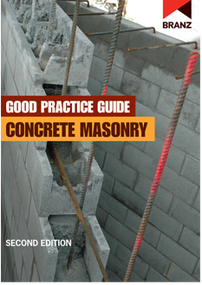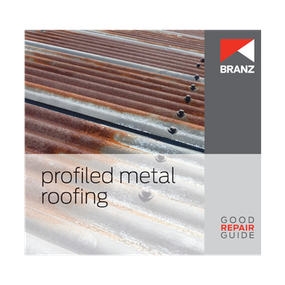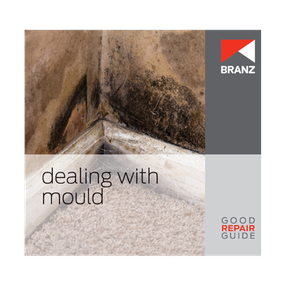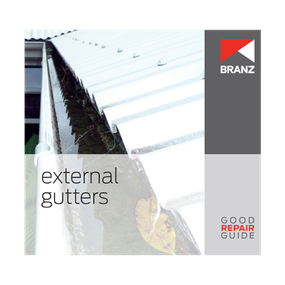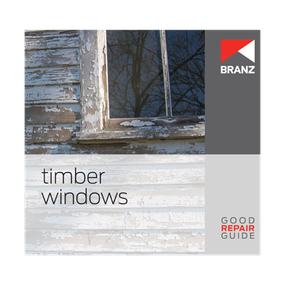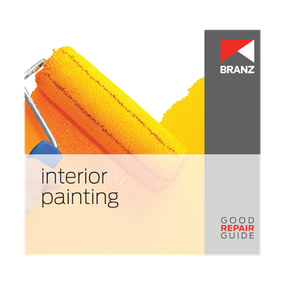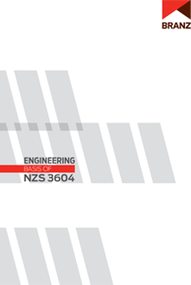Good Repair Guide: Construction stains
Building and renovation work can result in spills and splashes causing undesirable staining on nearby surfaces. The most common substances likely to cause staining if not handled or used correctly include:
- paints, varishes and stains (waterborne and solventborne)
- oil, grease and wax
- adhesives
- sealants (silicone and latex)
- concrete and cement-based mortar and grout
- asphalt and tar.
This Good Repair Guide covers:
- the solvents and cleaners available for stain removal and the procedures for removing different types of construction-related stains without damaging the underlying material
- physical removal options such as abrading, rubbing, sanding, scraping, sandblasting, grinding, steam cleaning, brushing or scouring where appropriate
- dry materials that may be applied to a stain or spillage.
Disclaimer: Please note that our publications reflect the regulations and best practices on the date of release, which is shown on the publication. As regulations and industry standards evolve, we always recommend that our publications be read in conjunction with the latest building code clauses and standards.
Good Practice Guide: Membrane roofing (2nd edition)
Membrane roofing systems come in a wide variety of types, each with their own substrate and installation requirements. Achieving a durable membrane roofing system depends on using the correct approach to the design of the substrate supporting the membrane and the membrane roofing itself. Using the correct membrane roofing system for the substrate, the slope, the use the roof will be put to and the aesthetic requirements of the building owner are also key requirements.
Written specifically for the New Zealand building industry, this guide covers the issues that need to be considered when selecting, designing, detailing and installing membrane roofing systems. Following the procedures outlined should significantly reduce the risk of problems occurring with membrane roofing.
This is an essential reference tool for all those involved in the selection, design or installation of a membrane roofing system.
Disclaimer: Please note that our publications reflect the regulations and best practices on the date of release, which is shown on the publication. As regulations and industry standards evolve, we always recommend that our publications be read in conjunction with the latest building code clauses and standards.
Seminar: Non-structural systems
This seminar provides designers and installers with a practical understanding of how to ensure non-structural systems in buildings are seismically resilient.
Please note that access to this recorded seminar will expire 1 month after purchase.
Designing for maintenance
Buildings are complicated. As part of the design process, the building designer must balance a range of potentially conflicting considerations such as:
- client (owner/developer) attitudes to costs and maintenance
- material and finish costs
- material and finish performance
- equipment cost and performance
- environmental conditions, both internal and external
- maintenance requirements and associated costs for the materials/components selected
- complexity of design and detailing
- aesthetics
- access
- the expected refurbishment cycles for the building
- building use and potential changes in use during its life
- potential changes in available technology
- safety.
Design and construction quality can also have a significant impact on the life expectancy of a building's materials and components as well as on the maintenance and renewal requirements.
The aim of this book is to outline maintenance issues that should be considered as part of the design process so that completed buildings are able to be effectively and economically maintained.
Disclaimer: Please note that our publications reflect the regulations and best practices on the date of release, which is shown on the publication. As regulations and industry standards evolve, we always recommend that our publications be read in conjunction with the latest building code clauses and standards.
Good Practice Guide: Profiled metal wall claddings (2nd edition)
This guide gives an overview of the issues to be considered when selecting, designing, detailing and installing profiled metal wall cladding systems. It identifies where and why problems are likely to occur and what care is needed to avoid potential problems. It emphasises the fact that the profiled metal sheets are just one part of the wall cladding system required to manage air and water penetration.
To satisfy New Zealand Building Code and owners' expectations for performance in all conditions, profiled metal claddings require the correct design and installation of the whole cladding system comprising cladding (profile and orientation), cavities, cladding underlays, air barriers, all associated fasteners and flashings
The intended audience for this guide includes architects, designers, cladding and building trades, building consent authorities, tertiary tutors and apprentices.
Disclaimer: Please note that our publications reflect the regulations and best practices on the date of release, which is shown on the publication. As regulations and industry standards evolve, we always recommend that our publications be read in conjunction with the latest building code clauses and standards.
Good Practice Guide: Timber cladding (3rd edition)
Timber cladding materials and skills needed for building and installation of traditional claddings have changed over the years. The conditions for building new timber-clad buildings have also changed over the years. Sites that would have earlier been avoided are now being built on, and buildings are also larger and more complex.
Other factors, such as weathertightness issues, have become more relevant. Designers have to consider carefully how they will achieve weathertight cladding solutions when traditional materials are being employed to satisfy homeowners' demands for complex buildings on more exposed sites.
This guide gives a comprehensive overview of the issues to be addressed by designers and installers of timber weatherboard and plywood sheet claddings.
Disclaimer: Please note that our publications reflect the regulations and best practices on the date of release, which is shown on the publication. As regulations and industry standards evolve, we always recommend that our publications be read in conjunction with the latest building code clauses and standards.
Good Repair Guide: External timber steps
External timber steps and handrails are exposed to all weather conditions, including regular wetting and drying and high levels of UV light. Regular wetting and drying causes swelling and shrinkage of the timber, while changes in ambient temperature results in continual thermal expansion and contraction. The constant movement of the timber causes warping and cupping, joints to open up, nails to pop and fixings to become loose. In addition, timber that remains wet for extended periods of time becomes slippery, and rotting may occur.
This Good Repair Guide identifies some of the common problems and repair options for external timber steps and handrails. When damage to external steps is extensive, the best option is often full replacement.
Disclaimer: Please note that our publications reflect the regulations and best practices on the date of release, which is shown on the publication. As regulations and industry standards evolve, we always recommend that our publications be read in conjunction with the latest building code clauses and standards.
Good Repair Guide: Driveways and paths
Driveways and paths require maintenance and may need to be repaired from time to time. The frequency and type of repair depends on the surface finish. Paths and driveways can become overgrown, and tree roots growing underneath are likely to cause cracking and unevenness of the surface.
This Good Repair Guide identifies some of the common problems with driveways and paths and describes repair options. If damage is extensive, however, the best option may be removal and a full replacement of the driveway or path, which is outside the scope of this guide.
Disclaimer: Please note that our publications reflect the regulations and best practices on the date of release, which is shown on the publication. As regulations and industry standards evolve, we always recommend that our publications be read in conjunction with the latest building code clauses and standards.
Seminar: Building science at work
This seminar provides an insight into how BRANZ research priorities are determined as well completed research, research for coming year, National Science Challenges and overseas research.
Please note that access to this recorded seminar will expire 1 month after purchase.
Good Repair Guide: Subfloor timber
A bouncy or springy floor or a floor that is noticeably uneven is often the first indication that there may be a problem with the subfloor framing.
Subfloor timbers include joists, bearers, wall plates, jack studs, braces and stringers. They are structural components of a building, and any damaged or understrength subfloor timbers must be repaired or replaced regardless of the cause.
This Good Repair Guide looks at the causes of common problems with subfloor timber and outlines the repair options.
Disclaimer: Please note that our publications reflect the regulations and best practices on the date of release, which is shown on the publication. As regulations and industry standards evolve, we always recommend that our publications be read in conjunction with the latest building code clauses and standards.
Good Repair Guide: Timber decking
Regular wetting and drying of timber decking results in timber swelling and shrinking. In combination with exposure to UV light and temperature changes, this can result in timber deterioration.
Timber slat decks are usually fully exposed to the weather. To deal with water dispersal, these decks have 3-6 mm gaps between the timber boards. Although villas and bungalows may have a roofed veranda or porch, the timber decking is still exposed to the weather. The decking in these houses is typically tongue and groove (T&G) boards, and they are laid with a fall to the exterior of the building to shed water.
This Good Repair Guide describes some of the common problems that can occur and how timber decking can be repaired and maintained.
Disclaimer: Please note that our publications reflect the regulations and best practices on the date of release, which is shown on the publication. As regulations and industry standards evolve, we always recommend that our publications be read in conjunction with the latest building code clauses and standards.
Good Repair Guide: Timber floorboards
Tongue and groove (T&G) timber floors laid over joists are a typical feature of older New Zealand homes. From the earliest houses until 1970s, all houses had timber floorboards.
Moisture changes in the timber can cause floorboards to expand and contract, and timber flooring is also susceptible to minor damage such as scuffs and scratches.
This Good Repair Guide describes the types of repairs that can be made where damage to floorboards is minor or localised. It does not cover major repairs or where the floor may need to be replaced as a result of subfloor or foundation failure.
Disclaimer: Please note that our publications reflect the regulations and best practices on the date of release, which is shown on the publication. As regulations and industry standards evolve, we always recommend that our publications be read in conjunction with the latest building code clauses and standards.
Good Practice Guide: Concrete masonry (2nd edition)
Single-skin masonry construction has a small but significant share of the New Zealand construction industry. It is seen as a robust construction system where the structural and weathertightness functions of a wall are carried out by a single construction element.
The guide covers performance requirements, design and detailing requirements, material selection, good construction practices, weathertightness and maintenance. It is well illustrated with photographs and three-dimensional drawings to explain the requirements of single-skin masonry from initial design requirements through to the weatherproof coating options.
This guide is an essential reference for designers and specifiers, masons, building contractors, building officials, and tutors and students of construction-related disciplines.
Disclaimer: Please note that our publications reflect the regulations and best practices on the date of release, which is shown on the publication. As regulations and industry standards evolve, we always recommend that our publications be read in conjunction with the latest building code clauses and standards.
Good Repair Guide: Profiled metal roofing
Profiled metal roofs may need replacing for a variety of reasons, including cladding failure due to corrosion, leaks due to poor initial design or installation, damage caused by wind or falling trees, the need to match an older roof to a newer addition or imply a desire to change the appearance of the roof.
This Good Repair Guide covers:
- why a roof may need replacing
- the steps to take when removing an existing profiled metal roof and replacing it with new longrun profiled metal roof cladding.
It does not cover the replacement of the profiled metal roof cladding with another roofing type.
Disclaimer: Please note that our publications reflect the regulations and best practices on the date of release, which is shown on the publication. As regulations and industry standards evolve, we always recommend that our publications be read in conjunction with the latest building code clauses and standards.
Good Repair Guide: Dealing with mould
As well as causing damage to building materials, internal mould growth in homes is unhealthy for many building occupants. While some moulds are harmless, others can cause health problems such as allergies, asthma and hay fever in some people, and a few moulds can cause more serious illness.
This Good Repair Guide outlines strategies for removing internal mould, controlling moisture and raising temperatures in order to minimise its reccurrence. It looks at what mould is, the problems and health consequences, cleaning methods for mould and improving ventilation.
Disclaimer: Please note that our publications reflect the regulations and best practices on the date of release, which is shown on the publication. As regulations and industry standards evolve, we always recommend that our publications be read in conjunction with the latest building code clauses and standards.
Good Repair Guide: External gutters
Roof gutters are an important component of the building envelope, designed to control the disposal of rainwater from the roof. The most important functions of gutters are to help protect against:
- excessive or concentrated wetting of external wall surfaces
- water getting inside the building roof space or wall framing
- increased wetness of soils around the building and subsequent increased moisture loads on basement waterproofing
- undermining of areas around the building where there is controlled spillage onto the ground.
Leaking or overflowing gutters may cause problems with dampness in subfloor areas or basements or elevated moisture levels in cladding and within wall framing.
This Good Repair Guide covers the repair or replacement of fully accessible metal and plastic external gutters around the outside perimeter of the building that are fixed to a fascia board or rafter ends. It does not cover gutters that are concealed behind a proprietary metal fascia or internal or within-roof gutters.
Disclaimer: Please note that our publications reflect the regulations and best practices on the date of release, which is shown on the publication. As regulations and industry standards evolve, we always recommend that our publications be read in conjunction with the latest building code clauses and standards.
Good Repair Guide: Timber windows
Until the 1970s, the main material used for window frames and sashes in New Zealand houses was timber. A large proportion of houses still have timber windows, and these can last for a very long time if well maintained and repaired when necessary.
This Good Repair Guide covers the repair of timber windows using materials and styles to match the existing. It looks at common problems, how to repair and replace windows, rules and regulations and health and safety.
Disclaimer: Please note that our publications reflect the regulations and best practices on the date of release, which is shown on the publication. As regulations and industry standards evolve, we always recommend that our publications be read in conjunction with the latest building code clauses and standards.
Good Repair Guide: Horizontal timber weatherboards
Over time, water entry through poorly installed or maintained weatherboard cladding may cause significant structural damage and other problems long before any symptoms become apparent on the exterior or interior of a building. Regular checks and proper maintenance are critical to ensuring weathertightness.
If a leak or any associated damage becomes obvious, it is advisable to consult a registered building surveyor in order to determine the extent of the problem and necessary repair options.
This Good Repair Guide highlights common problems and causes, types and extent of damage, rules and regulations, health and safety, tools, repairing and replacing weatherboards as well as related documents and standards.
Disclaimer: Please note that our publications reflect the regulations and best practices on the date of release, which is shown on the publication. As regulations and industry standards evolve, we always recommend that our publications be read in conjunction with the latest building code clauses and standards.
Good Repair Guide: Interior painting
All interior painted finishes within a domestic building deteriorate slowly over time and will require repainting to clean and freshen the surfaces or to continue protecting the substrate. The frequency of repainting depends on the amount of fading caused by UV exposure, damage or wear, and internal humidity levels - high levels of internal moisture that cause condensation to form on surfaces can result in mould growth, staining and paint deterioration.
Painted interior surfaces include ceilings, walls, window frames, doors and door frames, kitchen joinery and trims such as cornices (or scotias), architraves and skirtings. Materials that are likely to have a paint finish include timber, plasterboard, fibrous plaster, softboard, hardboard, fibre-cement, particleboard, MDF and pressed metal ceiling and wall panelling.
This Good Repair Guide highlights common problems, rules and regulations, health and safety, preparation, selecting paint, how to paint, brushes, roller and other applications, spray painting and cleaning up.
Disclaimer: Please note that our publications reflect the regulations and best practices on the date of release, which is shown on the publication. As regulations and industry standards evolve, we always recommend that our publications be read in conjunction with the latest building code clauses and standards.
Engineering basis of NZS 3604
This book is intended as a source document for those who need to know the basis for the engineering decisions underpinning NZS 3604 Timber-framed buildings.
NZS 3604 sets out the construction requirements for light timber-framed buildings in New Zealand that do not require specific structural engineering design. By limiting the size of the building and scope of application, a series of solutions are presented, enabling a designer to select an element or detail appropriate to the situation without needing to engage a structural engineer.
Disclaimer: Please note that our publications reflect the regulations and best practices on the date of release, which is shown on the publication. As regulations and industry standards evolve, we always recommend that our publications be read in conjunction with the latest building code clauses and standards.




